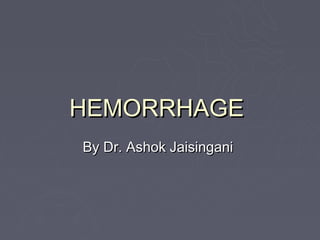
Hemmorrhage
- 1. HEMORRHAGE By Dr. Ashok Jaisingani
- 2. Definition & Introduction ► Escape of the blood from the vessels either internally or externally. ► Hemorrhage must be recognized and managed aggressively to reduce the severity and duration of shock and avoid death or multiple organ failure. ► Hemorrhage is treated by arresting the bleeding, not by fluid resuscitation or blood transfusion. ► To resuscitate the patients who have ongoing hemorrhage physiological exhaustion (coagulopathy, acidosis and hypothermia) and subsequently death.
- 3. Pathophysiology ► Hemorrhage hypovolemic shock cellular anaerobic metabolism lactic acidosis decrease function of coagulase protease coagulopathy further hemorrhage. ► This hemorrhage is exacerbated by the ischemic endothelial cells activating anticoagulant pathway. ► In compensatory state of the shock blood supply to the muscles is reduced, which become unable to generate the heat hypothermia ► As coagulation functions poorly at low temp. further hemorrhage. ► Further hypoperfusion and worsening acidosis and hypothermia physiological exhaustion “Death”
- 4. Effects Of Medical Therapy In Hemorrhagic Shock ► Medical therapy has a tendency to worsen this effect. ► Intravenous fluid and transfused blood are cold and worsening the hypothermia. ► During the surgery body cavity become open that leads to further heat loss. ► Crystalloid solution are acidic themselves. ► Thus every efforts made rapidly to stop hemorrhage and avoid physiological exhaustion such as 1- Coagulopathy 2- Acidosis 3- Hypothermia
- 5. Revealed Hemorrhage ► Revealed Hemorrhage is obvious external hemorrhage, result from 1- Exsanguination from open arterial wound 2- From massive haemetemesis 3- From duodenal ulcer
- 6. Concealed Hemorrhage ► Concealed hemorrhage is contained within the body cavity and must be suspected. Concealed hemorrhage may be 1- Traumatic concealed hemorrhage 2- Non – Traumatic concealed hemorrhage ► In trauma hemorrhage may be concealed within the chest, abdominal cavity, pelvis, retroperitonium or in limbus may be associated with concealed vascular injury and log bone fracture. ► Non – traumatic concealed hemorrhage include GIT bleeding & rupture aortic aneurysm
- 7. Primary Hemorrhage ► Hemorrhage occurring immediately as result of an injury or surgery is recognized as “ primary hemorrhage”
- 8. Recreationary Hemorrhage ► Recreationary hemorrhage is delayed hemorrhage within 24 hours and usually caused by the 1- Dislodgement of clot by the resuscitation 2- Normalization of blood pressure 3- Vasodilatation (cessation of reflex vasospasm) 4- Technical failure such as slippage of ligature
- 9. Secondary Hemorrhage ► Secondary hemorrhage is caused by the sloughing of the wall of vessels ► It usually occurs 7 – 14 days after the injury and precipitated by the factors such as 1- Infection 2- Pressure necrosis (result from drain) 3- Malignancy
- 10. Surgical & Non-surgical hemorrhage ► Surgical hemorrhage is the result of injury and amenable to surgical control, or from angioembolism ► Non – surgical hemorrhage is general ooze from all raw surface due to coagulopathy, it can not be stopped by surgical mean, require correction coagulation abnormalities ► Note: Packing can stop non-surgical hemorrhage
- 11. Degree & Classification Of Hemorrhage ► Degree of hemorrhage classified in to 4 classes 1- Blood volume loss < 15% 2- Blood volume loss between 15 – 30% 3- Blood volume loss between 30 – 40% 4- Blood volume loss > 40% ► Estimation of amount of blood that has been lost is difficult and inaccurate and usually underestimation of actual value ► Hemoglobin level is a poor indicator of the hemorrhage as it represent conc. Not actual amount ► In early stage of the rapid hemorrhage HB conc. Become unchanged, but later HB and haemotcrit will fall.
- 12. Basis Of Hemorrhagic Treatment ► Treatment of the hemorrhage depend upon degree of the hypovolemic shock according to 1- Vital Signs 2- Preload assessment 3- Base deficit 4- Most important among these is dynamic response to fluid therapy. ► In non-responder or transitient responder pts it is necessary to identify and control the site of the bleeding.
